 Ansible介绍与使用
Ansible介绍与使用
# 企业级自动化运维工具Ansible
# 一、介绍
# 1.自动化运维工具对比
1.Puppet:基于 Ruby 开发,采用 C/S 架构,扩展性强,基于SSL,远程命令执行相对较弱;
2.SaltStack:基于 Python 开发,采用 C/S 架构,相对 puppet 更轻量级,配置语法使用YAML,使得配置脚本更简单.需要配置客户端以及服务器端。每台被控制节点需要安装agent;
3.Ansible:基于Python开发,分布式,无需客户端,轻量级,配置语法使用YAML语言,更强的远程命令执行操作;
2
3
# 2.Ansible简介
ansible是自动化运维工具,基于Python开发,分布式,无需客户端,轻量级,实现了批量系统配置、批量程序部署、批量运行命令等功能,ansible是基于模块工作的,本身没有批量部署的能力。真正具有批量部署的是ansible所运行的模块,ansible只是提供一种框架。
Ansible特性
1)、no agents:不需要在被管控主机上安装任何客户端,更新时,只需在操作机上进行一次更新即可(不用安装客户端。分布式的)
2)、no server:无服务器端,使用时直接运行命令即可
3)、modules in any languages:基于模块工作,可使用任意语言开发模块
4)、yaml,not code:使用yaml语言定制剧本playbook
5)、ssh by default:基于SSH工作
6)、strong multi-tier solution:可实现多级指挥
2
3
4
5
6
7

connection plugins:连接插件,负责和被监控端实现通信,默认使用SSH连接。
host inventory:主机清单,是一个配置文件里面定义监控的主机。
modules : 模块,核心模块、command模块、自定义模块等。
plugins : modules功能的补充,包括连接插件,邮件插件等。
playbook:编排,定义 Ansible 多任务配置文件,非必需。
2
3
4
5
# 二、ansible安装
# 1、 准备环境----关闭防火墙和selinux
环境:
主机:4台 1个控制节点 3个被控制节点
解析:本地互相解析(所有机器)
# vim /etc/hosts
192.168.1.10 ansible-web1
192.168.1.11 ansible-web2
192.168.1.12 ansible-web3
192.168.1.9 ansible-server (控制节点服务器端)
配置ssh公钥认证:控制节点需要发送ssh公钥给所有被控制节点
[root@ansible-server ~]# ssh-keygen
[root@ansible-server ~]# ssh-copy-id -i 192.168.1.10 #所有被控节点机器
所有机器:
systemctl stop firewalld && setenforce 0
2
3
4
5
6
7
8
9
10
11
12
13
14
# 2、安装
安装:控制节点
1. 配置EPEL网络yum源
[root@ansible-server ~]# yum install -y epel-release
2. 安装ansible
[root@ansible-server ~]# yum install -y ansible
3.查看版本
[root@ansiable-server ~]# ansible --version
4.看帮助
[root@ansible-server ~]# ansible --help
2
3
4
5
6
7
8
9
# 3、ansible基础----inventory主机清单
官方文档: http://docs.ansible.com/ansible/intro_inventory.html#>
inventory文件通常用于定义要管理主机的认证信息,例如ssh登录用户名、密码以及key相关信息。
查看配置文件:
[root@ansible-server ~]# rpm -qc ansible
/etc/ansible/ansible.cfg
/etc/ansible/hosts #ansible主机清单文件
-q:---query查询
1.主配置文件:
/etc/ansible/ansible.cfg #主要设置一些ansible初始化的信息,比如日志存放路径、模块、等配置信息
2.主机清单文件:
默认位置/etc/ansible/hosts
2
3
4
5
6
7
8
9
10
11
语法:
1.添加主机或者主机组:
[root@ansible-server ~]# vim /etc/ansible/hosts #在最后追加被管理端的机器
ansible-web1 #单独指定主机,可以使用主机名称或IP地址
2.添加主机组:
[webservers] #使用[]标签指定主机组 ----标签自定义
192.168.10.11 #如果未解析添加ip
ansible-web2 #解析添加主机名
3.组可以包含其他组:
[webservers1] #组一
ansible-web1
[webservers2] #组二
ansible-web2
[weball:children] #children-照写 #weball包括两个子组
webservers1 #组一
webservers2 #组二
4.为一个组指定变量,组内每个主机都可以使用该变量:
[weball:vars] #设置变量,vars--照写
ansible_ssh_port=22
ansible_ssh_user=root
ansible_ssh_private_key_file=/root/.ssh/id_rsa
#ansible_ssh_pass=test #也可以定义密码,如果没有互传秘钥可以使用密码。
2
3
4
5
6
7
8
9
10
11
12
13
14
15
16
17
18
19
20
21
22
Ansible Inventory 常见的内置参数:
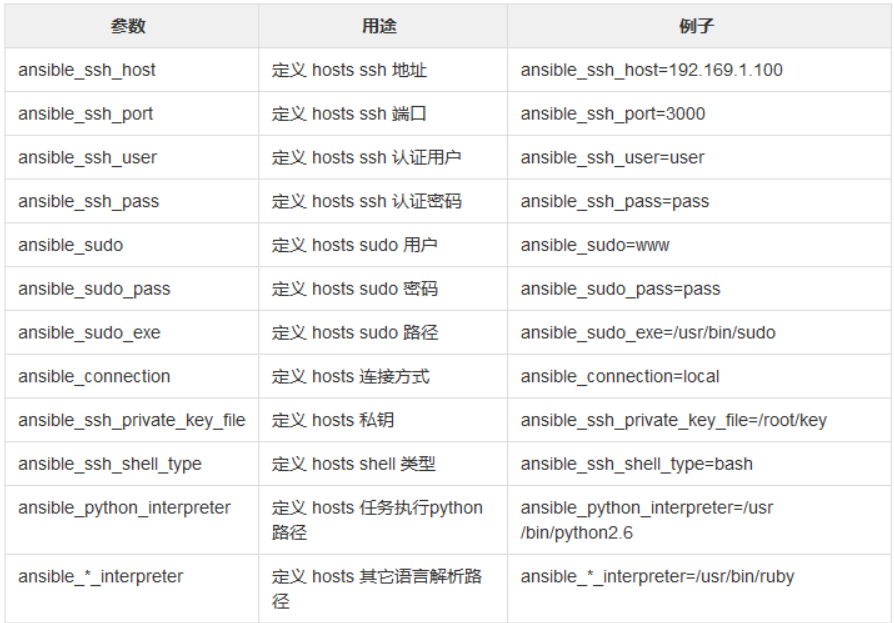
查看组内主机列表:
语法:ansible 组名 --list-hosts
[root@ansible-server ~]# ansible weball --list-hosts
hosts (2):
ansible-web1
ansible-web2
====================================
扩展:自定义主机列表使用密码登录:(了解)
[root@ansible-server ~]# vim /opt/hostlist
[all:vars]
ansible_ssh_port=22
ansible_ssh_user=root
ansible_ssh_private_key_file=/root/.ssh/id_rsa
#ansible_ssh_pass=test
[all]
ansible-web1
ansible-web2
使用:
[root@ansible-server ~]# ansible -i /opt/hostlist all -m ping -o
小注释:如果不通,手动连接第一次,第一次需要手动输入密码。"第一次"
-i:指定清单文件
注意:这里的ping并不是真正意义上的ping而是探测远程主机ssh是否可以连接!判断ssh端口是否存活
2
3
4
5
6
7
8
9
10
11
12
13
14
15
16
17
18
19
20
21
22
23
# 4、测试
语法:
# ansible <pattern> -m <module_name> -a <arguments>
pattern--主机清单里定义的主机组名,主机名,IP,别名等,all表示所有的主机,支持通配符,正则
-m module_name: 模块名称,默认为command
-a arguments: 传递给模块的参数
-o 单行显示
2
3
4
5
6
使用案例:
使用ping模块检查ansible节点的连通性:
1.指定单台机器:
[root@ansible-server ~]# ansible ansible-web1 -m ping -o
2.同时指定多台机器:
[root@ansible-server ~]# ansible ansible-web1,ansible-web2 -m ping -o
3.指定组名:
[root@ansible-server ~]# ansible webservers1 -m ping -o
2
3
4
5
6
7
8
9
10
执行shell命令:
[root@ansible-server ~]# ansible webservers1 -m shell -a 'uptime'
ansible-web1 | CHANGED | rc=0 >>
23:32:47 up 5:24, 3 users, load average: 0.00, 0.01, 0.05
不加 -m 默认是 command 模块
[root@ansible-server ~]# ansible webservers1 -a 'uptime'
ansible-web1 | CHANGED | rc=0 >>
23:34:01 up 5:25, 3 users, load average: 0.16, 0.05, 0.06
2
3
4
5
6
7
8
1.给节点增加用户:
[root@ansible-server ~]# ansible webservers1 -m shell -a 'useradd tom'
ansible-web1 | CHANGED | rc=0 >>
[root@ansible-server ~]# ansible webservers1 -m shell -a 'grep tom /etc/passwd'
ansible-web1 | CHANGED | rc=0 >>
tom:x:1000:1000::/home/tom:/bin/bash
重定向输出到本地文件中:
[root@ansible-server ~]# ansible webservers1 -m shell -a 'df -Th' > /opt/a.txt
[root@ansible-server ~]# cat /opt/a.txt
ansible-web1 | CHANGED | rc=0 >>
Filesystem Type Size Used Avail Use% Mounted on
/dev/mapper/centos-root xfs 18G 1.1G 17G 6% /
devtmpfs devtmpfs 226M 0 226M 0% /dev
tmpfs tmpfs 237M 0 237M 0% /dev/shm
tmpfs tmpfs 237M 4.7M 232M 2% /run
tmpfs tmpfs 237M 0 237M 0% /sys/fs/cgroup
/dev/sda1 xfs 1014M 125M 890M 13% /boot
tmpfs tmpfs 48M 0 48M 0% /run/user/0
2
3
4
5
6
7
8
9
10
11
12
13
14
15
16
17
18
# 5、Ad-Hoc
ad hoc其实就是执行简单的命令——一条命令。对于复杂的命令则为 playbook。
帮助文档:
列出ansible支持的模块:
-l:获取列表
-s module_name:获取指定模块的使用信息
看所有模块(A10,华为,docker,EC2,aws等等广大厂商设备)
[root@ansible-server ~]# ansible-doc -l
查看模块使用信息,了解其功能:
[root@ansible-server ~]# ansible-doc -s yum
2
3
4
5
6
7
8
常用模块
1.远程复制备份模块:copy
模块参数详解:
src=:指定源文件路径
dest=:目标地址(拷贝到哪里)
owner:指定属主
group:指定属组
mode:指定权限,可以以数字指定比如0644
backup:在覆盖之前将原文件备份,备份文件包含时间信息。有两个选项:yes|no
[root@ansible-server ~]# vim a.txt #创建一个测试文件
123123
[root@ansible-server ~]# ansible weball -m copy -a 'src=/root/a.txt dest=/opt owner=root group=root mode=644' -o
[root@ansible-server ~]# vim a.txt #追加如下内容
123123
234234
[root@ansible-server ~]# ansible weball -m copy -a 'src=/root/a.txt dest=/opt/ owner=root group=root mode=644 backup=true' -o
注释:如果文件没有变化,不会备份。只有文件内容不同,才会做备份。
登录被控制机器其中一台查看
[root@ansible-web1 ~]# cat /opt/a.txt.15301.2019-09-01\@00\:35\:18~
[root@ansible-server ~]# ansible weball -m shell -a 'mv /mnt/auka.txt /tmp' -o
移动被控制节点的文件
2
3
4
5
6
7
8
9
10
11
12
13
14
15
16
17
18
19
20
21
22
2.软件包管理 yum模块
安装apache
[root@ansible-server ~]# ansible webservers1 -m yum -a "name=httpd state=latest" -o
state= #状态是什么,干什么
state=absent 用于remove安装包
state=latest 表示最新的
state=removed 表示卸载
卸载软件:
[root@ansible-server ~]# ansible webservers1 -m yum -a "name=httpd state=removed" -o
或者
[root@ansible-server ~]# ansible webservers1 -m yum -a "name=httpd state=absent" -o
2
3
4
5
6
7
8
9
10
11
3.服务管理service模块
[root@ansible-server ~]# ansible webservers1 -m service -a "name=httpd state=started" #启动
[root@ansible-server ~]# ansible webservers1 -m service -a "name=httpd state=stopped" #停止
[root@ansible-server ~]# ansible webservers1 -m service -a "name=httpd state=restarted" #重启
[root@ansible-server ~]# ansible webservers1 -m service -a "name=httpd state=started enabled=yes" #开机启动
[root@ansible-server ~]# ansible webservers1 -m service -a "name=httpd state=started enabled=no" #开机关闭
2
3
4
5
6
4.文件模块file
模块参数详解:
owner:修改属主
group:修改属组
mode:修改权限
path=:要修改文件的路径
recurse:递归的设置文件的属性,只对目录有效
yes:表示使用递归设置
state:
touch:创建一个新的空文件
directory:创建一个新的目录,当目录存在时不会进行修改
#创建一个文件
[root@ansible-server ~]# ansible webservers1 -m file -a 'path=/tmp/youngfit1.txt mode=777 state=touch'
[root@ansible-server ~]# ansible ansible-web2 -m file -a 'path=/tmp/youngfit2.txt mode=777 owner=nginx state=touch'
#创建一个目录
[root@ansible-server ~]# ansible webservers1 -m file -a 'path=/tmp/auka mode=777 state=directory'
被控节点ansible-web2操作:
[root@ansible-web2 tmp]# cd /opt/
[root@ansible-web2 opt]# ll haha
total 0
-rw-r--r--. 1 root root 0 Sep 12 09:41 haha2.txt
-rw-r--r--. 1 nginx root 0 Sep 12 09:41 haha.txt
[root@ansible-server ~]# ansible ansible-web2 -m file -a "path=/opt/haha owner=nginx group=nginx state=directory recurse=yes"
被控节点查看:
[root@ansible-web2 opt]# ll haha
total 0
-rw-r--r--. 1 nginx nginx 0 Sep 12 09:41 haha2.txt
-rw-r--r--. 1 nginx nginx 0 Sep 12 09:41 haha.txt
2
3
4
5
6
7
8
9
10
11
12
13
14
15
16
17
18
19
20
21
22
23
24
25
26
27
28
29
30
31
5.收集信息模块setup
[root@ansible-server ~]# ansible webservers1 -m setup #收集所有信息
[root@ansible-server ~]# ansible webservers1 -m setup -a 'filter=ansible_all_ipv4_addresses' #只查询ipv4的地址
filter:过滤
2
3
4
# 三、ansible-playbook 剧本(1)
Playbook介绍
playbook是ansible用于配置,部署,和管理被控节点的剧本。通过playbook的详细描述,执行其中的tasks,可以让远端主机达到预期的状态。playbook是由一个或多个”play”组成的列表。 当对一台机器做环境初始化的时候往往需要不止做一件事情,这时使用playbook会更加适合。通过playbook你可以一次在多台机器执行多个指令。通过这种预先设计的配置保持了机器的配置统一,并很简单的执行日常任务。
ansible通过不同的模块实现相应的管理,管理的方式通过定义的清单文件(hosts)所管理的主机包括认证的方式连接的端口等。所有的功能都是通过调用不同的模块(modules)来完成不同的功能的。不管是执行单条命令还是play-book都是基于清单文件。
playbook格式
playbook由yaml语言编写。YMAL格式是类似于JSON的文件格式,便于人理解和阅读,同时便于书写。
一个剧本里面可以有多个play,每个play只能有一个tasks,每个tasks可以有多个name
核心元素:
Playbooks
Variables #变量元素,可传递给Tasks/Templates使用;
Tasks #任务元素,由模块定义的操作的列表,即调用模块完成任务;
Templates #模板元素,使用了模板语法的文本文件;
Handlers #处理器元素,通常指在某事件满足时触发的操作;
Roles #角色元素
2
3
4
5
6
7
playbook的基础组件:
name:
定义playbook或者task的名称(描述信息),每一个play都可以完成一个任务。
hosts:
hosts用于指定要执行指定任务的主机.
user:
remote_user则用于指定远程主机上的执行任务的用户
tasks:
任务列表play的主体部分是task list. task list中的各任务按次序逐个在hosts中指定的所有主机上执行,即在所有主机上完成第一个任务后再开始第二个。
vars:
定义变量(如果不使用内部变量需要提前定义)
vars_files:
调用定义变量文件
notify:
任务执行结果如果是发生更改了的则触发定义在handler的任务执行
handlers:
用于当前关注的资源发生变化时采取一定指定的操作
2
3
4
5
6
7
8
9
10
11
12
13
14
15
16
17
实例一:
[root@ansible-server ~]# cd /etc/ansible/
[root@ansible-server ansible]# vim test.yml #创建文件必须以.yml/.yaml结尾
---
- hosts: webservers1
user: root
tasks:
- name: playbook_test
file: state=touch path=/tmp/playbook.txt
===================================================================================
参数解释:
hosts: 参数指定了对哪些主机进行操作;
user: 参数指定了使用什么用户登录远程主机操作;
tasks: 指定了一个任务.
name:参数同样是对任务的描述,在执行过程中会打印出来。
2
3
4
5
6
7
8
9
10
11
12
13
14
15

检测语法:
[root@ansible-server ansible]# ansible-playbook --syntax-check test.yml
playbook: test.yml
运行Playbook:
[root@ansible-server ansible]# ansible-playbook test.yml #加剧本名称
2
3
4
5
实例二
handlers:由特定条件触发的Tasks
handlers:处理器
notify:触发器
语法:
tasks:
- name: TASK_NAME
module: arguments #1.上面任务执行成功,然后
notify: HANDLER_NAME #2.通知他
handlers:
- name: HANDLER_NAME #3.一一对应,这里的描述与notify定义的必须一样
module: arguments #4.执行这个命令
=======================================================
[root@ansible-server ansible]# vim handlers.yml
- hosts: webservers1
user: root
tasks:
- name: test copy
copy: src=/root/a.txt dest=/mnt
notify: test handlers
handlers:
- name: test handlers
shell: echo "abcd" >> /mnt/a.txt
========================================================
说明:只有 copy 模块真正执行后,才会去调用下面的 handlers 相关的操作,追加内容。所以这种比较适合配置文件发生更改后,需要重启服务的操作。
2
3
4
5
6
7
8
9
10
11
12
13
14
15
16
17
18
19
20
21
22
23
24
25
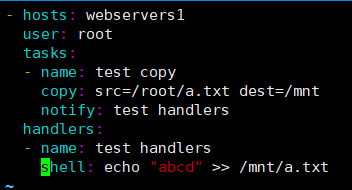
检测语法:
[root@ansible-server ansible]# ansible-playbook --syntax-check handlers.yml
playbook: handlers.yml
[root@ansible-server ansible]# ansible-playbook handlers.yml
2
3
4
案例三
循环:迭代,需要重复执行的任务;
对迭代项的引用,固定变量名为”item”,使用with_items属性给定要迭代的元素;
基于字符串列表元素实战:
[root@ansible-server ansible]# vim list.yml
- hosts: webservers2
remote_user: root
tasks:
- name: install packages
yum: name={{ item }} state=latest #相当于for循环里面的i
with_items: #取值 。但是不支持通配符
- httpd
- php
- php-mysql
- php-mbstring
- php-gd
2
3
4
5
6
7
8
9
10
11
12
13
14
15
16
17
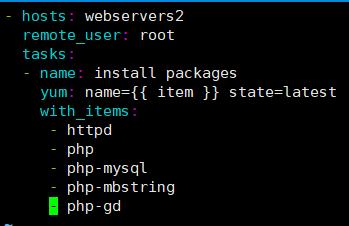
检测语法:
[root@ansible-server ansible]# ansible-playbook --syntax-check list.yml
playbook: list.yml
执行:
[root@ansible-server ansible]# ansible-playbook list.yml
2
3
4
5
案例四、自定义vars_files变量
变量调用语法:
{{ var_name }}
====================================================
创建变量目录:
[root@ansible-server ~]# mkdir /etc/ansible/vars
[root@ansible-server ~]# cd /etc/ansible/vars/
[root@ansible-server vars]# vim file.yml #创建变量文件。
src_path: /root/test/a.txt
dest_path: /opt/test/
2
3
4
5
6
7
8
9
10

创建一个测试文件
[root@ansible-server vars]# mkdir /root/test
[root@ansible-server vars]# vim /root/test/a.txt #编辑测试文件
123
创建play-book引用变量文件:
[root@ansible-server vars]# cd /etc/ansible/
[root@ansible-server ansible]# vim vars.yml
- hosts: ansible-web1
user: root
vars_files:
- /etc/ansible/vars/file.yml
tasks:
- name: create directory
file: path={{ dest_path }} mode=755 state=directory
- name: copy file
copy: src={{ src_path }} dest={{ dest_path }}
2
3
4
5
6
7
8
9
10
11
12
13
14
15
16
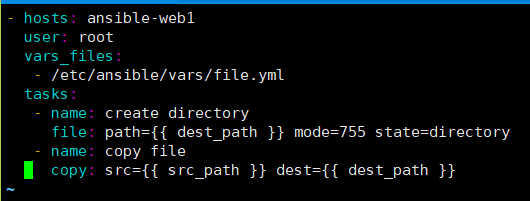
检测语法:
[root@ansible-server vars]# cd ..
[root@ansible-server ansible]# ansible-playbook --syntax-check vars.yml
playbook: vars.yml
执行:
[root@ansible-server ansible]# ansible-playbook vars.yml
2
3
4
5
6
登录查看:
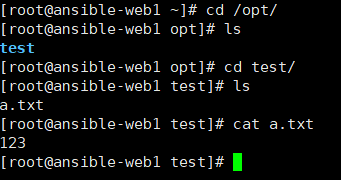
实战:通过playbook安装apache
1.准备工作:
[root@ansible-server ansible]# vim hosts #添加主机web3
[webservers3]
ansible-web3
2.安装apache,准备配置文件
[root@ansible-server ~]# yum install -y httpd
[root@ansible-server ~]# mkdir /apache
[root@ansible-server ~]# cp /etc/httpd/conf/httpd.conf /apache/ #将配置文件推送到web3
3.修改端口将原来的80修改为8080
[root@ansible-server ~]# vim /apache/httpd.conf
Listen 8080
[root@ansible-server ~]# cd /etc/ansible/ #编写剧本
[root@ansible-server ansible]# vim apache.yml
---
- hosts: webservers3
user: root
tasks:
- name: install apache
yum: name=httpd state=latest
- name: copy conf file
copy: src=/apache/httpd.conf dest=/etc/httpd/conf/httpd.conf
notify: start httpd
handlers:
- name: start httpd
service: name=httpd state=restarted
2
3
4
5
6
7
8
9
10
11
12
13
14
15
16
17
18
19
20
21
22
23
24
25
26
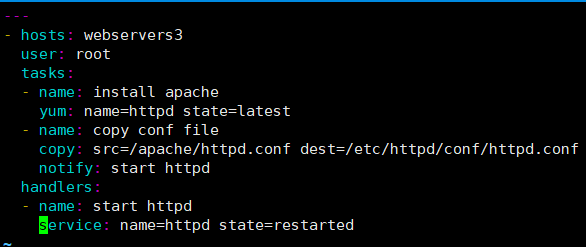
语法检测:
[root@ansible-server ansible]# ansible-playbook --syntax-check apache.yml
playbook: apache.yml
执行play-book
[root@ansible-server ansible]# ansible-playbook apache.yml
2
3
4
5
登录web3查看:

